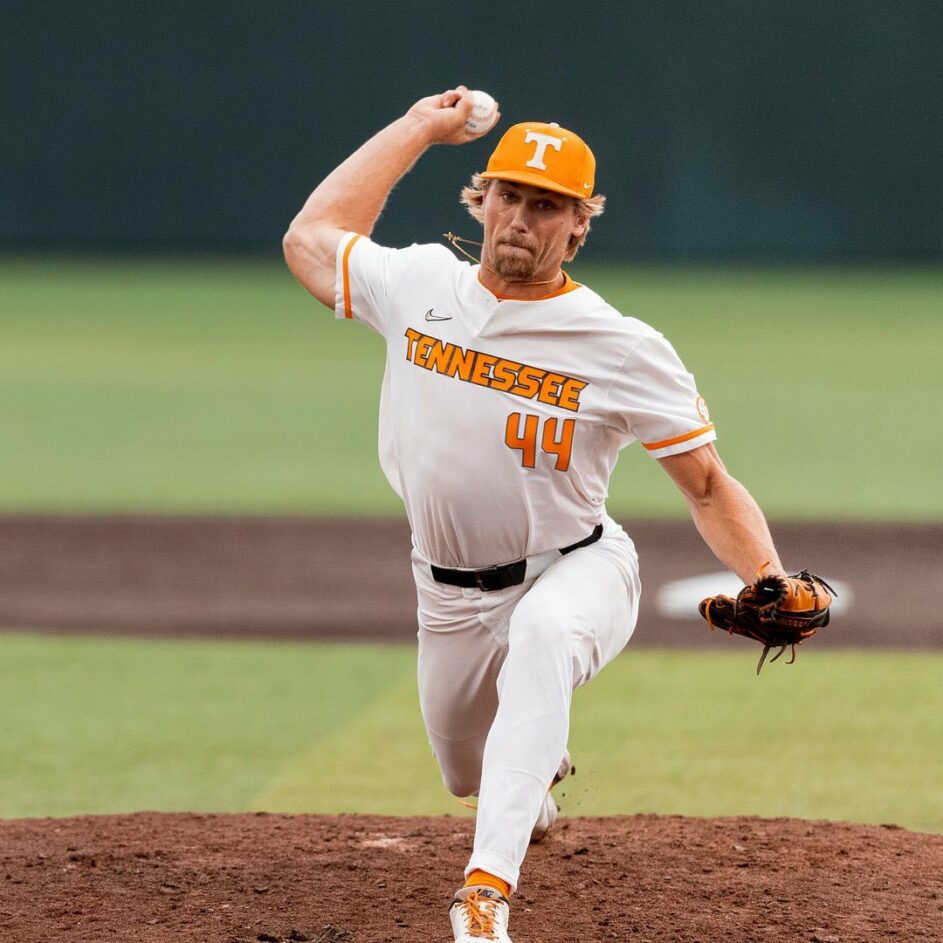In baseball lingo, Tennessee flamethrower Ben Joyce “brings it.”
The homegrown right-hander (Farragut High Admirals, Walters State Senators and the Volunteers) delivered the fastest pitch of the college season, 105.5 miles per hour. It may have been historic. Still checking the radar.
Fast was not a fluke. Dozens of Joyce pitches faster than 100 were considered plain ordinary.
Fifty-three batters struck out in his 32-1/3 innings, 26 relief appearances and one start. Tennessee fans stood and cheered. Other knowledgeable observers were in awe. There was a traffic jam on the Internet.
Tony Vitello was cautious. The UT coach, feeling the obligation to shelter Joyce in his first year forward from Tommy John repairs, imposed pitch limits, appearance limits and stress limits.
Super scouts, analytical visionaries and riverboat gamblers, braintrust of the major league baseball draft, were skeptical. They asked a thousand questions in their quest to discover who Ben Joyce really is.
He is 6-5 and 230. He’ll be 22 come September. He looks like a full-grown man.
So, he throws hard but he gave up 18 hits, 14 walks, eight earned runs and five homers. How can that be? Why is he so inexperienced? Is he injury-prone?
Vitello, other coaches and Ben’s dad spin the record the opposite direction. The pitcher is low-mileage, the arm is fresh and strong, the best is yet to come.
“There’s a lot of development left to be done,” said Vitello. “He’s a puppy as it relates to pitching.”
Competitive? You bet! He fussed (respectfully) when the coach took away the ball.
Decision-makers tip-toed around the mystery. Everybody knows the draft is a guessing game. Scouts try to see into the future. Maybe he is a wild card. Maybe he will end up in the hall of fame. One-oh-five-point-five is intoxicating.
Ben Joyce was drafted by the Angels, next to last in the third round. Those who sign checks supposedly appreciated the wait-and-see approach. The pitcher has a choice, too. He is pretty good at addition and subtraction. He has a degree in finance, an interest in a masters and another year of eligibility. He can sign for what he can get, a lot but less than the jackpot, or stay in school and go for 106 mph.
The Joyce story might be a movie. Ben has a twin brother, Zach, a fraction of an inch shorter, two or three pounds lighter and not quite as fast with his fastball.
Once upon a time, they had to struggle to make the team at Farragut. They were small, 5-5 and maybe 100, as freshmen. They grew. They made the varsity as juniors. They didn’t do all that much.
Coach Matt Buckner worried about where they would go from there. Credentials were limited but Buckner had a friend at Walters State …
Ben missed his first season in Morristown because of a stress fracture in his elbow. He pitched 20 innings as a sophomore. Zach, as a freshman, pitched in the junior college world series. Vitello read potential. Of course the sophomores committed to Tennessee.
Almost immediately Zach blew out his elbow. He considered giving up baseball but eventually had Tommy John surgery. A year later, at UT, Ben had the same affliction and operation – minus the hesitation.
Ben recovered. Zach decided he’d had enough. He mentioned “mental health” and walked away from baseball. Ben threw 105.5. Zach asked if he could come back. Vitello said “of course.”
We’ll see which Joyce does what next season. Let us hope for happiness.
Tennessee fans seemed disappointed that Ben was not a first-rounder on Sunday evening. Most draft experts were not surprised. They had penciled him into the third round. I was told it might be later.
How in the world could professional evaluators be so wrong?
Vitello said so few innings were a stumbling block. Potential is exciting. History is more meaningful.
Fifty-three strikeouts in 32 innings? Strong numbers. Many of the outs had shirts that said Xavier, Tennessee Tech, Western Carolina, Eastern Kentucky, Iona, UNC-Asheville and Georgia Southern.
None said New York, Houston or Los Angeles. Same game, 60 feet, six inches from top of the mound to home plate. Scouts contend the challenge is different.
Marvin West welcomes reader comments or questions. His address is marvinwest75@gmail.com

